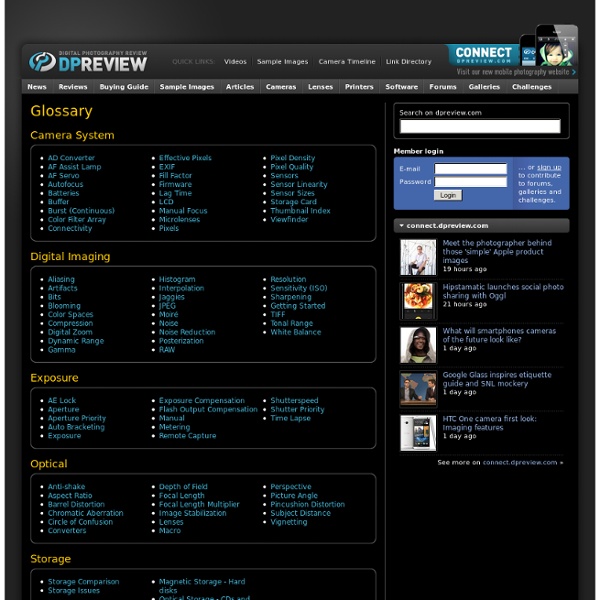



http://www.dpreview.com/glossary
Related: PhotographyKeep Shooting!: dpreview.com Editorial blog: Digital Photography Review There is a school of thought that says the more of you shoot the better the chances of getting a good set of photographs. Hobbyist photographer Juha Haataja proves how true this is. In 21 months he has crossed an exceptional 100,000 shots with his Panasonic Lumix DMC-LX3 camera, averaging to around 150 shots per day. Whichever way you look at it, this is a huge number - there are professional-grade cameras that take pride in promising this kind of longevity.
Understanding Evaluative Metering on Your EOS Camera Photo by Flickr user MiNe By Andrew S. Gibson – the author of Understanding Exposure: Perfect Exposure on Your EOS Camera (currently 36% off at SnapnDeals). Imagine that it is early 1959. Create a Photo-Realistic Orange from Scratch - Photoshop Tutorial Step 1 Create a circle using the ellipse tool. Orange should not have a smooth spherical shape. So we need to make it irregular. Add anchor points as in the figure and create and make the circle irregular. Step 2 On Lenses For Small Cameras: dpreview.com Editorial blog: Digital Photography Review The year 2009 will surely be remembered by photographers as that which finally saw the long-overdue arrival of the large-sensor compact system camera. Indeed ever since compact digicams were first introduced, the obvious next step seemed to be to develop the basic concept with larger sensors and interchangeable lenses; so much so that the only real question has been, what's taken so long? But now that Olympus and Panasonic have blazed the trail with the likes of the E-P1 and GF1, and Samsung has shown its hand in the shape of the NX10, it seems only a matter of time before all of the major manufacturers jump on board and produce their own competitors in this potentially lucrative new market segment. But while we've certainly been pleased to see these new cameras, we've been less impressed by the lack of imagination shown by the initial lens ranges. Who's it for? What's it for?
15 Tips for Successful Fireworks Photography With the summer coming up and different celebrations you may have the opportunity to photograph some fireworks. If you’re in the USA you have the 4th of July, in Canada July 1st. In many other places you can find fireworks festivals or competitions even, or special occasions when fireworks may be set off including weddings, New Years Day or course and of course at Disneyland! So here’s a few tips to help you photograph fireworks. The biggest thing to remember is that it’s all about practice, experimentation, and the following mantra (say it with me!)
Micro trends: Graphic design aesthetics We’re not interested in trends for their own sake. For many designers, the very word ‘trend’ is something of a taboo, conjuring up images of blind imitation of whatever’s hot at any given time, rather than encouraging genuine innovation and independent creative thought. Rest assured, you won’t find any of that here.
Four Thirds ●Angle of view and focal lengthThe angle of view represents the subject range that can be imaged with the image sensor, and is expressed in degrees. The shorter the focal length of the lens, the greater the angle of view (i.e. the lens is wide-angle), and the longer the focal length, the smaller the angle of view (i.e. the lens is telephoto). The angle of view is determined by the lens' focal length and the image sensor's diagonal length, and usually expressed with the following formula. Photography: How to Take Sharper Pictures Welcome If I had a nickel for every time someone with a new camera blamed the camera itself as the reason why their pictures aren’t coming out as crisp as those seen in photo books, magazines, or even this website, I’d be able to pay someone to write this guide for me. Unfortunately, I don’t. So here I am.
100+ Tips on Creating an Effective Online Portfolio Online portfolios are one of a freelancer’s greatest marketing tools. You can reference it in your business cards, promotional campaigns, email signatures, and clients can find you on their own through search engines – generating you new business. Your portfolio is the face of your business and needs to communicate well on its own online. Your business goals with a portfolio are clear: you want to convert those visitors into customers. We all have to start somewhere with displaying our work. Buying a digital SLR: Guides: Learn Updated September 2013 Why buy a digital SLR? So you've decided to invest in a new digital camera and have made your mind up that you want to step up to a digital SLR, but the huge range of models on offer and endless flow of technical jargon have left you more confused than when you started?